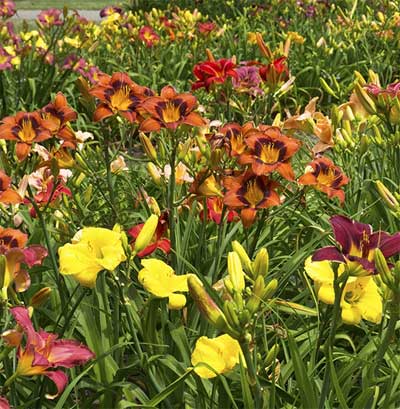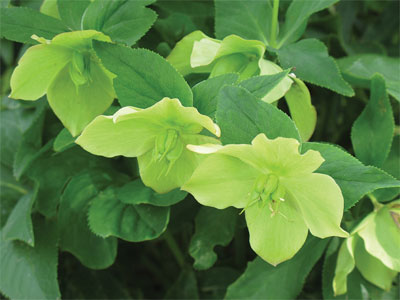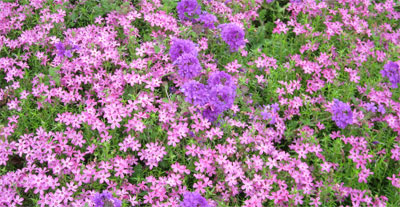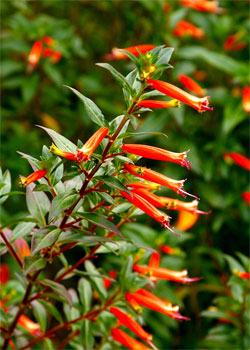From the Magazine: July 2014

There may be no surer symbol of summer in the garden than daylilies. Hybridizers have now given us these time-honored “workhorses” in thousands of color combinations and fascinating forms.
Photo by Neil Sperry.
by Sharon Lee Smith
The Joys of Perennials
Mind-bending flower and foliage color for every season
Growing perennials is an endless joy. Each year as spring approaches and the plants begin to sprout, I am amazed at what returns. I am pleased to see how the plants have multiplied while dormant. It seems I always forget one or two new additions from the previous year, and when they reappear, they provide a wonderful surprise. In the process of planting my perennial gardens I have taken into consideration the blooming cycle of the plants. I enjoy having flowers to look at for as much of the year as possible.
Winter
Obviously, winter is the hardest part of the year to fill with color. Heuchera (known as coral bells) do a superb job of providing foliage color during that time of year. There are many varieties of coral bells on the market with varying shades of green, chartreuse, coral, orange, or maroon leaves. Some offer silver veining, but all provide interest and color in partial-shade areas, and all bloom in the spring.

Hellebores are perennials that bring foliar interest to the garden in winter, plus graceful, rose-like blossoms in late winter and early spring. Photo by Carolyn Skei.
Hellebores are undoubtedly the most popular plant for late-winter color. The flowers resemble roses. While the charming flowers are not showy from afar, you can enjoy them if the plants are placed up close along a walkway or near an entrance.
Daffodils and narcissus grown from bulbs are hardy perennials, returning and multiplying year to year. Drought tolerant, the plants require at least partial sun to prosper. Many of the small-blooming ones have a lovely fragrance.
Spring
Let’s consider spring as March through mid-May in our part of the United States. One of the earliest flowers to bloom is the old-fashioned creeping phlox called thrift. It sports the most outrageous fuchsia-pink flower color you’ve ever seen, and what a welcome into spring it provides! Newer varieties are definitely toned down a bit, but all exhibit the same great qualities. All the creeping phlox varieties make excellent borders and will drape nicely over a wall. The plants need sun and good drainage to thrive. Verbena is equally happy in these conditions. Many groundcover types will fill a large space quickly if given a sunny location.

Old-fashioned creeping phlox and purple ‘Homestead’ verbena make lush, low-growing companions in early spring.
Photo by Sharon Lee Smith.
Bearded iris are old-fashioned favorites, but newer selections are capable of both spring and fall bloom. The plants are extremely drought-tolerant, but they will multiply faster when watered regularly. Plant heights range from 12 inches to 3-1/2 feet tall. Many now have scented flowers.
Yarrow is a delightful plant, quite useful as a cut flower. Hybridization has produced plants that are well mannered and long blooming in a wide range of colors. Different varieties reach different heights, so place them in your beds accordingly.
Summer
Summer in Texas usually arrives – bringing us heat – in mid- to late May. Many plants fill the summer months with color. However, I consider daylilies the workhorses of the early-summer garden. Grown easily in sun to part shade, they tolerate dry conditions and return faithfully. The color range, flower types and plant heights vary widely, so there really is something for everyone.
The native plant gaura is another staple in my beds. Blooming May through fall if deadheaded on occasion, the long wands of pink or white flowers add a bit of whimsy to a bed. I tend to plant gaura along with many types of salvias. The blooms of salvias are colorful and attractive to butterflies and hummingbirds. Tall varieties are perfect for the back of a border, while many in the 3- to 4-foot range are tidy enough for most beds.
Over the last few years, I have become enamored of perennial hibiscus. Many varieties need a large space, but the huge, gaudy flowers are showy from far away. Regular watering is required, but the plants reward you with blooms for many months.

Cigar plant is a show-off in fall – and one of the last plants to bloom before autumn gives way to winter. Photo by Neil Sperry.
Fall
Fall has become one of my favorite times of year. It is a treat to see that nature provides us with late-season color. Asters and mums are the most popular fall plants, but Tagetes lemonii and Tagetes lucida (perennial marigolds) both show off bright gold flowers. Hardy cigar plants are one of the last to bloom, and the flowers look like candy corn on long spikes.
It’s exciting to have something new in bloom in the garden as the seasons pass, and with just a bit of planning, it is easy to accomplish.
